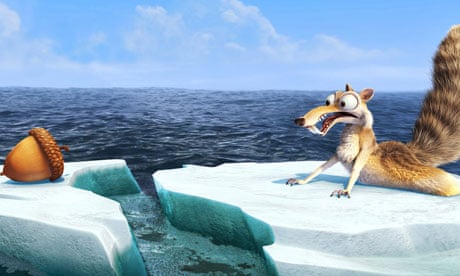The idea that the continents drifted apart after once forming a unified whole is among the most familiar elements of our worldview – so much so that it can readily form the premise for a kids' holiday blockbuster. Yet the notion was resisted furiously right until the 1960s. As an apparently unproven theory, it repelled people; as reluctantly accepted fact, perhaps it remains unsettling.
Ice Age 4: Continental Drift doesn't present the phenomenon entirely accurately. The film has the Pangean super-continent breaking up two million years ago; 200 million would have been nearer the mark. As shown, the process takes a matter of minutes, rather than tens of millions of years. The film's version of the fracture's cause – a sabre-toothed squirrel's misadventure with an acorn – flies in the face of scientific opinion. These details apart, however, its broad thrust is sound enough.
It was in 1596 that a Flemish cartographer called Abraham Ortelius noticed the apparent fit between the coastlines of Africa and South America, and conjectured the movement of land-masses as a possible explanation. However, no one took the proposition seriously until a meteorologist named Alfred Wegener presented the case for "continental displacement" to the Frankfurt Geological Association in 1912.
Wegener showed that the geology of the Appalachians matched that of the Scottish Highlands, and that rock strata occurring in Brazil also appeared in South Africa. The fossils of tropical plants could be found on Spitsbergen. Marsupials in South America and Australia were not only similar but hosted similar flatworm parasites. However, these revelations failed to attract an excited welcome: the association's minutes noted dismissively that there was "no discussion due to the advanced hour".
On the contrary, the educated classes of both Europe and America joined ranks to spend much of the next half-century attacking Wegener's "delirious ravings" and trying to demolish both his hypothesis and his character. They justified their animosity by complaining that he was unable to explain convincingly what might make continents move. Nonetheless, other startling but initially inexplicable observations, ranging from gravity to quantum mechanics, have won relatively ready acceptance.
It's true that Wegener fell foul of a shift in scientific fashion from field observation to laboratory experiment. Yet the intensity of the vituperation directed at him suggests that something deeper may also have been involved. Belief in the solidity of the planet was so long-standing and deeply rooted that people weren't even aware that it was a belief. The theory of continental drift put a bomb under geological orthodoxy, but it also threatened more widely held assumptions.
Creationists realised that the time scale it implied challenged their doctrine that the world was no more than a few thousand years old. Others, however, were also troubled: if the very Earth could shift underneath your feet, what else might also give way?
On all sides, what had seemed unassailable scientific, social, political and economic realities were collapsing. The thought that the land itself might be inconstant encapsulated the fears of the age. People must have felt a hint of the panic that grips mammoths Manny and Ellie, Sid the sloth, molehog Louis and sabre-toothed Diego in Ice Age 4. One minute the mammoths are grappling with the comfortingly familiar problem of adolescent angst; the next, as teenage mammoth Peaches puts it, "Everything we know is gone."
In 1968, the geophysicist Jack Oliver effectively removed any remaining room for doubt by providing the explanation for land-mass mobility that had eluded Wegener. Continents, he showed, didn't move around on top of the seabed; the whole of the earth's crust was agitated by continuous convection currents, like scum on top of a boiling stew. It was the heat that built up under terrain that set it in motion.
For us, the picture is even more alarming than it was for our great-grandparents, since the process Oliver uncovered isn't actually complete. Not only have the continents moved apart; they're still moving, and will always do so. Like the creatures in Ice Age 4, we're adrift on the surface of our planet, but unlike them we shall never come to rest.
Psychologists identify a cognitive counterpart (pdf) to the migration of the continents, and suggest that this can infect attitudes to geopolitics. If our sense of tectonic trends might influence our thinking, it might be useful to know just where they're heading. Unfortunately, forecasting this kind of thing is an uncertain business, which should hardly surprise us since we don't even know yet whether we'll see the sun this summer.
Still, a Texan geologist called Christopher Scotese has attempted to track the continents' likely future itineraries by studying their past journeys. Guess what: he reckons that they're all on course to join up again in a new Pangea Ultima. First, Africa will crash into Eurasia; then Australasia will pile in. For a while, the Americas will move further away, but then they too will turn up to join the party.
A mere 250 million years from now, we could be back in the kind of world whose loss Peaches so prettily mourns. Unlike her primordial self, however, we'll be all too sadly aware that it won't be staying that way for ever.
Yet take heart. If Hollywood stays true to form, it should be able to help out. It could provide us with at least one beacon of permanence that will doubtless be welcome indeed amid so much uncertainty. Eventually, Pangea Ultima's multiplexes will surely play host to Ice Age 84,327,862: Continental Combination.

Comments (…)
Sign in or create your Guardian account to join the discussion